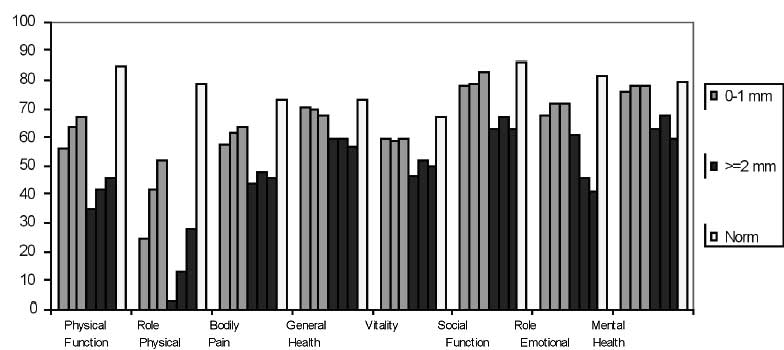
Fri., 10/14/11 Pelvis & Spine, Paper #48, 11:03 am OTA-2011
Quality of Life Following Acetabular Fracture Surgery, Importance of Reduction
Tomas Borg, MD, PhD; Sune Larsson, MD, PhD;
Dept. of Orthopaedic Surgery, Uppsala University, Uppsala, Sweden
Purpose: This study was conducted to determine patient-reported outcome following internal fixation of acetabular fractures using quality of life (QoL) instruments.
Methods: 136 patients (108 men, 28 women), aged 17 to 83 years and operated for an acetabular fracture during 2004 to 2008, were prospectively included and followed for 2 years. QoL was evaluated via Short Form-36 (SF-36) and Life Satisfaction-11 (LiSat-11) at 6, 12, and 24 months. Radiographs were evaluated according to Matta at 2 years.
Results: 129 patients could be assessed, 4 did not respond, and 3 had died; 115 patients responded at all 3 time points. The most frequent fracture types were posterior wall (n = 31), associated anterior-posterior hemitransverse (n = 34), and associated both-column (n = 29). Patients scored significantly lower than norms in all SF-36 domains with significant improvement over time for Physical Function (P <0.001) and Role Physical (P <0.001). Patients with anatomic reduction (n = 92) scored significantly better (P <0.001 to 0.039) in all domains except vitality (P = 0.070) when compared with patients with residual displacement of 2 mm or more (n = 23). There were no significant differences in SF-36 between patients with preserved hip joint and 19 patients who had undergone arthroplasty. LiSat-11 was significantly lower for patients compared with norms in 9 of 11 items with no change between 6 months and 2 years. For the items “friends/acquaintances” and “financial situation,” there was no difference between patients and norms.
Conclusions: Anatomic reduction in acetabular fracture patients results in better QoL when compared with patients with residual displacement. Physical SF-36 domains improve with time, although at 2 years patients still had lower QoL than norms.

Figure 1. SF-36 scores (mean) in acetabular fracture patients at 6, 12, and 24 months following surgery. Divided in 2 groups, anatomic reduction (light gray, n = 92) and residual displacement 2 mm or more (dark gray, n = 23), compared with normative data.
Alphabetical Disclosure Listing (628K PDF)
• The FDA has not cleared this drug and/or medical device for the use described in this presentation (i.e., the drug or medical device is being discussed for an “off label” use). ◆FDA information not available at time of printing. Δ OTA Grant.